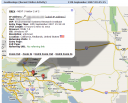This probably old news but I’m pretty impressed by it. I’m referring to the recent visitor map on StatCounter.com. We do a lot of web development where I work (both GIS and not) and I like to keep an eye on tools that may be useful in that area. StatCounter provides a free service that keeps track of who’s visiting a site. It can track IP, referring links, etc. It’s pretty standard stuff but their reporting tools are nice so I thought I’d check it out.
Anyway, one feature they have that I didn’t know about when I signed up is a “recent visitor map” that places push-pins on Google Maps to identify where your visitors are coming from. Clearly it’s using some form of GeoIP and it’s not exact (no, I can’t find your house with it unless you live at your ISP). I instrumented my blog and it shows a good spread from all over the world. StatCounter has a javascript version and a version based on a web bug. Both can be mapped but the javascript version gives you more information, including things like referring links. My blog is hosted on WordPress.com which doesn’t allow me to embed script tags in posts or widgets (ahem) but I instrumented another site with the javascript version and it works well. A screen capture of the map is below:
If you click on a push-pin you access information such as IP address, ISP, city/state/country, time spent on the page, OS, browser, referring page, etc. This has the potential to be a good, low-key business intelligence tool. You can see where your visitors are coming from and, with the javascript version, how they’re getting there. On the other web site, I have discovered that a lot of traffic is driven there via some of my ArcScripts posts, with a lesser degree coming from my blog. The biggest referrer tends to be Google and you can actually see the full query string so you can see the search terms.
As for the web bug version I set up on my blog, I’ve been able to figure out that a couple of big system integrators (who act as their own ISP) are interested in SharpMap.
I find this tool to be an ideal application of the push-pin mapping concept.
Update: Here’s another example showing some of the specific interest generated by the “Death of ESRI” post (the IP address and host name have been blurred to protect the innocent):


It’s not mine. Just go to http://www.statcounter.com, register for an account and follow the steps.
How to get your recent visitor script